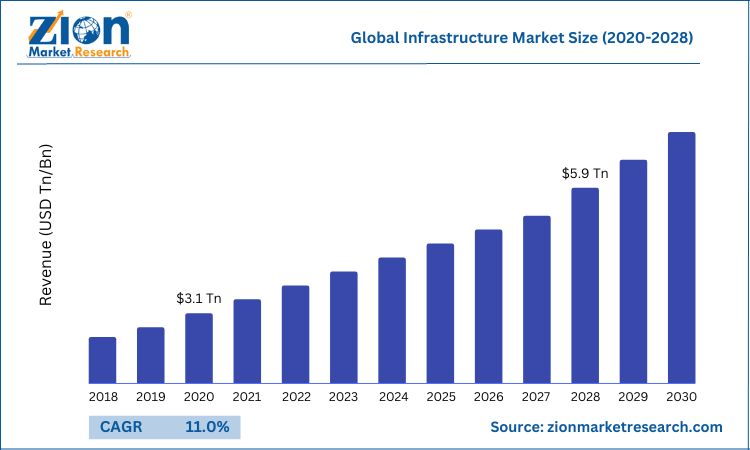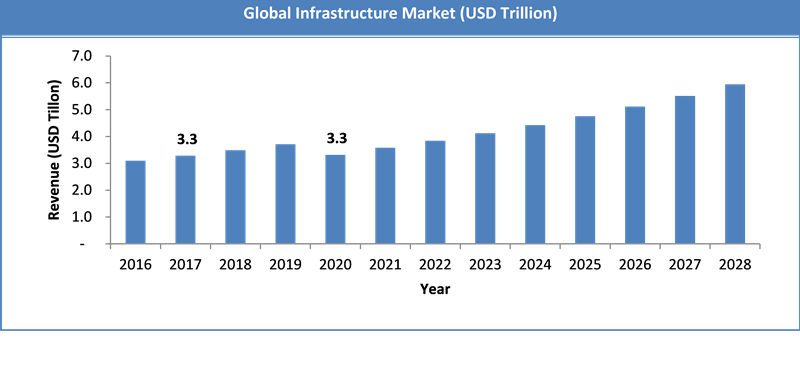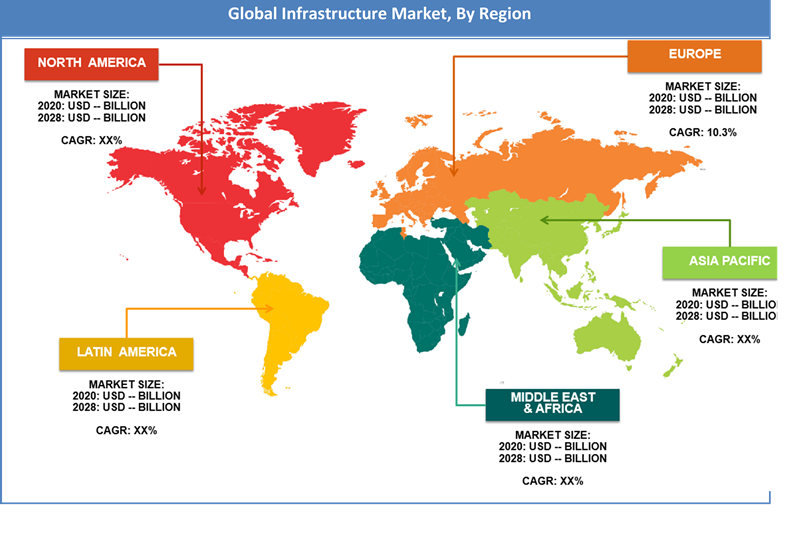Infrastructure Market Size, Share Report, Analysis, Trends, Growth 2034

Infrastructure Market by Application (Residential/Non-Residential Construction, Energy and Utilities Infrastructure, Transport Infrastructure, and Others): Global Industry Perspective, Comprehensive Analysis and Forecast, 2025-2034
| Market Size in 2024 | Market Forecast in 2034 | CAGR (in %) | Base Year |
|---|---|---|---|
| USD 4753.68 Billion | USD 13842.08 Billion | 11.28% | 2024 |
Infrastructure Market: Industry Statistics
The global Infrastructure market accounted for USD 4753.68 Billion in 2024 and is expected to reach USD 13842.08 Billion by 2034, growing at a CAGR of around 11.28% between 2025 and 2034.
Infrastructure Market Overview
Infrastructure is the facilities and systems that support the sustainable functionality of households and firms. Increased impetus to develop infrastructure in various country is attracting both domestic and international players. The private sector is emerging as a key player across various infrastructure segments, ranging from roads and communications to power and airports. In order to boost the construction of buildings in India, the Government of India has decided to come up with a single window clearance facility to accord speedy approval of construction projects.
Development of highways would be undertaken, including the development of 2,500 km access control highways, 9,000 km of economic corridors, 2,000 km of coastal and land port roads, and 2,000 km of strategic highways. FASTag mechanism encourages greater commercialization of highways, enabling the NHAI to raise more resources. It was proposed to monetize at least 12 lots of highway bundles of over 6,000 km before 2024.
How Digitalization Connected to Infrastructure Market:
The infrastructure industry is becoming more digitalized, and the use of technology is playing an increasingly essential role in the design, building, and management of infrastructure projects. This trend is expected to continue in the foreseeable future. The following are some of the ways in which technological advancements are influencing the market for infrastructure:
Smart Infrastructure: The integration of sensors, data analytics, and technologies related to the Internet of Things (IoT) is enabling infrastructure to become "smart," with real-time data being collected and analyzed in order to improve decision-making and optimize performance.
Building Information Modeling (BIM): BIM is a digital representation of a building or infrastructure project. It is being used more frequently in the market for infrastructure to improve the planning, design, and construction of projects.
Drones and other unmanned aerial vehicles (UAVs): Drones are being used to inspect and survey infrastructure. This helps to improve the speed and accuracy of the inspection process, while also reducing the need for workers to physically inspect infrastructure. Drones and UAVs are referred to collectively as "drones."
Virtual and Augmented Reality: Virtual and augmented reality technologies are being used in the infrastructure market to simulate and visualize projects. This enables stakeholders to experience a project before it is built and makes it easier for them to make informed decisions about the design and construction processes.
Digital Project Management: The use of digital tools and platforms is enabling businesses operating in the infrastructure market to manage projects in a more effective manner. Real-time data and collaboration capabilities are improving the rate at which projects are completed, while also enhancing their precision.
The expanding use of technology in the market for infrastructure is leading to increased efficiency, cost savings, and sustainability, all of which are helping to shape the industry's future.
COVID-19 Impact Analysis:
The pandemic has been significantly impacted infrastructure development and the global economy. International response to the rapid disruption to infrastructure and construction sectors and industries is ongoing. Infrastructure sector notes provide a quick and short analyses on the impact of the pandemic on different infrastructure sectors while proposing recommendations for an effective response to this global crisis.
The significant decrease in the global Infrastructure market size in 2024 is estimated on the basis of the COVID-19 outbreak and its negative impact on the economies and industries across the globe. Various scenarios have been analyzed on the basis of inputs from various secondary sources and the current data available about the situation.
Infrastructure ?Market Growth Factors
Tremendous growth in Infrastructure industry is mainly due to rapidly growing manufacturing sectors and developing services, growing consumer demand and government commitments to recover the economic conditions of rural population and revive the agricultural sector.
Infrastructure sector is well poised to take a big leap, and it presents several investment opportunities for foreign investors from across the world. Infrastructure development reflects the health of the economy of any nation, as infrastructure is directly proportional to the growth and development. Being a rapidly growing nation, India has always given higher importance to the infrastructure sector, and it has received considerable attention from the government as well as private players.
The market for infrastructure presents numerous chances for expansion, including the following:
Government Investment: Governments all over the world are pouring money into various infrastructure projects as a means of fostering economic expansion and producing new employment opportunities. Because of this, businesses will have a lot of opportunities to grow in the infrastructure market.
Emerging markets: As the economies of emerging nations continue to expand, so does the demand for infrastructure to sustain these economies. This creates opportunities for businesses that operate in the infrastructure industry.
Renewable Energy: The transition towards renewable energy sources is giving rise to new infrastructure projects, such as wind and solar farms, which call for the expertise of businesses that specialize in the infrastructure industry.
Technological advancements: The use of new technologies, such as smart infrastructure, is allowing businesses in the infrastructure industry to perform their work in a more efficient and cost-effective manner.
Public-private partnerships (PPPs): PPPs are becoming an increasingly popular way to finance infrastructure projects. Additionally, they offer opportunities for businesses operating in the infrastructure market to participate in the financing, design, construction, and maintenance of infrastructure projects.
In addition to these prospects for expansion, the market for infrastructure is also confronted with constraints, such as limited funding, complex rules, and public opposition to particular projects. Nevertheless, businesses that are capable of successfully navigating these hurdles will be in a strong position to capitalize on the growing prospects in the infrastructure market.
Report Scope:
| Report Attributes | Report Details |
|---|---|
| Report Name | Infrastructure Market Size Report |
| Market Size in 2024 | $4753.68 Billion |
| Market Forecast in 2034 | $13842.08 Billion |
| Compound Annual Growth Rate | CAGR of 11.28% |
| Number of Pages | 209 |
| Forecast Units | Value (USD Billion), and Volume (Units) |
| Key Companies Covered | Larsen & Toubro, Gammon India, Reliance Infrastructure, Bechtel Group, Inc., China State Construction Engineering Corporation (CSCEC), Fluor Corporation, AECOM, CH2M Hill, Bouygues Construction, Vinci S.A., Hochtief AG, ACS Group, Skanska AB |
| Segments Covered | By Type,By end-user, And By Region |
| Regions Covered | North America, Europe, Asia Pacific (APAC), Latin America, Middle East and Africa (MEA) |
| Countries Covered | North America: U.S and Canada Europe: Germany, Italy, Russia, U.K, Spain, France, Rest of Europe APAC: China, Australia, Japan, India, South Korea, South East Asia, Rest of Asia Pacific Latin America: Brazil, Argentina, Chile The Middle East And Africa: South Africa, GCC, Rest of MEA |
| Base Year | 2024 |
| Historical Year | 2020 to 2024 |
| Forecast Year | 2025 - 2034 |
| Customization Scope | Avail customized purchase options to meet your exact research needs. Request For Customization |
Development in Infrastructure Market
Indian economy is booming, with rates of Gross Domestic Product growth exceeding 8% every year since 2004. The infrastructure sector is a foremost driver for the Indian economy. This sector is highly responsible for driving the overall development of India and experiencing strong focus from the government for initiating policies that would make sure time-bound creation of world class infrastructure in this country. Indian infrastructure sector is well poised to take a big leap and it presents several investment opportunities for foreign investors from across the world.
For development in the infrastructure sector, the Government of India has always been very proactive. India needs over USD 1.5 trillion in investment during coming 10 years to bridge infrastructure gap as the government aims to connect 700 thousand villages with roads by 2019 as part of a massive modernization plan. Key segments Indian infrastructure market includes residential/non-residential construction, energy and utility infrastructure, transport infrastructure and others. Modernization of Airports has been progressing satisfactorily.
In 2015, transport sector emerged as one of the prominent segment of Indian infrastructure market with 28% share of the overall market. Transport infrastructure includes road, railway, inland water transport, sea and coastal transport and air transport infrastructure. An efficient, reliable, and safe transport system is vital for fostering rapid economic growth. In the recent years, economic liberalization has quickened the impulses of economic growth. Rapidly growing middle-class needs of domestic and international trade, the large-scale mobility of working population to longer distances and growing demographic pressure have fuelled further demand for transport.
Technological up gradation is needed in traffic control system. With the increase in traffic, the development of non-Metro Airports would be taken up at the accelerated pace through private sector participation. The Indian power sector itself has an investment potential of USD 250 billion in the next 4 to 5 years, providing immense opportunities for power generation, distribution, transmission, and equipment, according to Union minister of coal, power and renewable energy.
For the growth in the India Energy Infrastructure, investments in ports, railways, pipelines and power transmission are urgently needed to attract energy sector investments in the first place and to enable efficient energy choices.
Infrastructure Industry Segment Analysis Preview
Residential/Non-Residential Construction is the largest segment in the infrastructure. Transport infrastructure sector emerged as one of the prominent segments of infrastructure market with 24.58% share of the overall market in 2024. Transport infrastructure includes road, railway, inland water transport, sea and coastal transport and air transport infrastructure.
Infrastructure Market Regional Preview:
Regionally, Asia Pacific has been leading the worldwide Infrastructure market and is anticipated to continue on the dominant position in the years to come. Infrastructure spending is closely aligned with GDP growth; annual average global growth is projected to stand at 3.0% in 2016−2024. This comes following a quieter 2011.28−2015, when global economic growth averaged 2.2%.
Key Market Players & Competitive Landscape
The major players operating Infrastructure market are
- Larsen & Toubro
- Gammon India
- Reliance Infrastructure
- Bechtel Group, Inc.
- China State Construction Engineering Corporation (CSCEC)
- Fluor Corporation
- AECOM
- CH2M Hill
- Bouygues Construction
- Vinci S.A.
- Hochtief AG
- ACS Group
- Skanska AB, etc.
The global Infrastructure market is segmented as follows:
By Application
- Residential/Non-Residential Construction
- Energy And Utilities Infrastructure
- Transport Infrastructure
- Others
By Region
- North America
- The U.S.
- Canada
- Europe
- France
- The UK
- Spain
- Germany
- Italy
- Rest of Europe
- Asia Pacific
- China
- Japan
- India
- South Korea
- Southeast Asia
- Rest of Asia Pacific
- Latin America
- Brazil
- Mexico
- Rest of Latin America
- Middle East & Africa
- GCC
- South Africa
- Rest of Middle East & Africa
Table Of Content
Methodology
FrequentlyAsked Questions
The global Infrastructure Market was valued at USD 4753.68 Billion in 2024.
The global Infrastructure Market is expected to reach USD 13842.08 Billion by 2024, growing at a CAGR of 11.28% between 2025 to 2034.
Some of the key factors driving the global Infrastructure Market growth are rapidly growing manufacturing sectors and developing services, growing consumer demand and government commitments to recover the economic conditions
Asia Pacific has been leading the worldwide Infrastructure market and is anticipated to continue on the dominant position in the years to come.
Some of the major players of global Infrastructure market Bechtel Group, Inc., China State Construction Engineering Corporation (CSCEC), Fluor Corporation, AECOM, CH2M Hill, Bouygues Construction, Vinci S.A., Hochtief AG, ACS Group, Skanska AB, etc.
List of Contents
Industry StatisticsMarket OverviewHow Digitalization Connected to Market:COVID-19 Impact Analysis:?Market Growth FactorsReport Scope:Development in MarketIndustry Segment Analysis PreviewMarket Regional Preview:Key Market Players Competitive LandscapeThe global market is segmented as follows:RelatedNews
HappyClients
Zion Market Research
Tel: +1 (302) 444-0166
USA/Canada Toll Free No.+1 (855) 465-4651
3rd Floor,
Mrunal Paradise, Opp Maharaja Hotel,
Pimple Gurav, Pune 411061,
Maharashtra, India
Phone No +91 7768 006 007, +91 7768 006 008
US OFFICE NO +1 (302) 444-0166
US/CAN TOLL FREE +1 (855) 465-4651
Email: sales@zionmarketresearch.com
We have secured system to process your transaction.
Our support available to help you 24 hours a day, five days a week.
Monday - Friday: 9AM - 6PM
Saturday - Sunday: Closed








